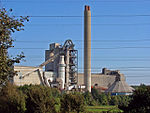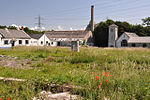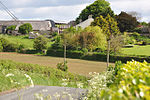Aberthaw High Level railway station
Beeching closures in WalesDisused railway stations in the Vale of GlamorganFormer Barry Railway stationsPages with no open date in Infobox stationRailway stations in Great Britain closed in 1964 ... and 3 more
Railway stations in Great Britain opened in 1897Use British English from January 2018Wales railway station stubs
Aberthaw High Level railway station was a Vale of Glamorgan Railway station operated by the Barry Railway which served Aberthaw, located near the north shore of the Bristol Channel in the former Welsh county of South Glamorgan, and in the current county of Vale of Glamorgan.
Excerpt from the Wikipedia article Aberthaw High Level railway station (License: CC BY-SA 3.0, Authors).Aberthaw High Level railway station
Station Terrace,
Geographical coordinates (GPS) Address External links Nearby Places Show on map
Geographical coordinates (GPS)
| Latitude | Longitude |
|---|---|
| N 51.38934 ° | E -3.38854 ° |
Address
Aberthaw High Level
Station Terrace
CF62 3DG , Rhoose
Wales, United Kingdom
Open on Google Maps









